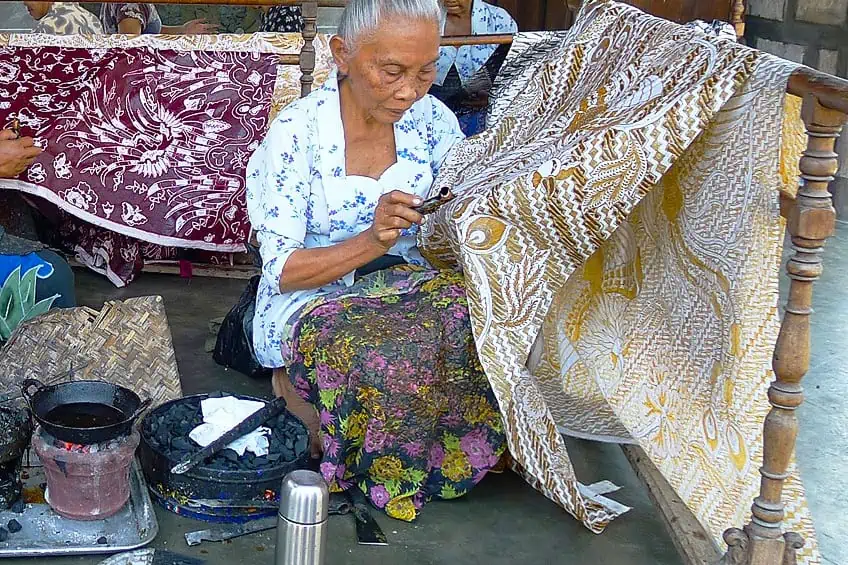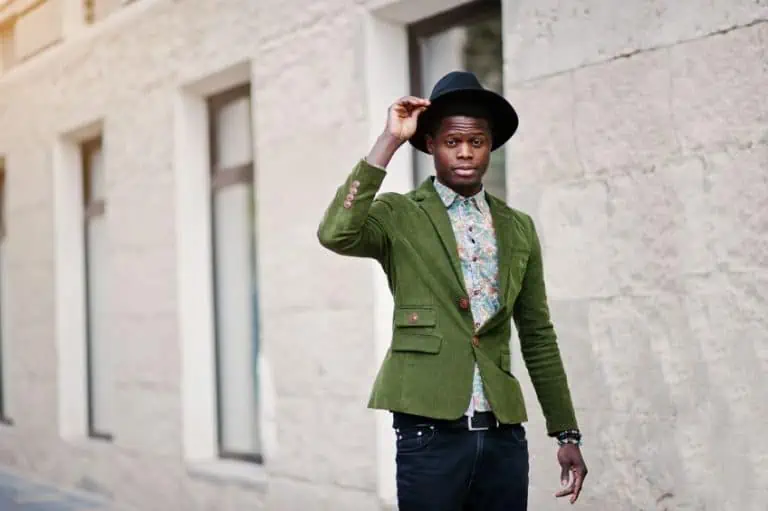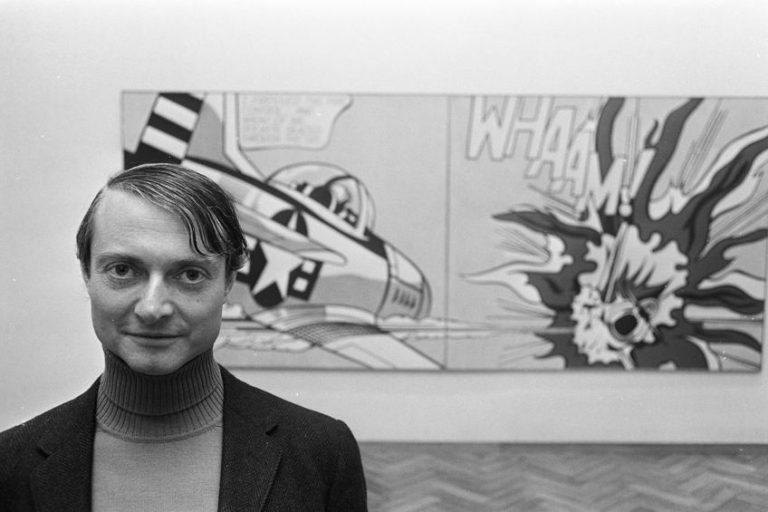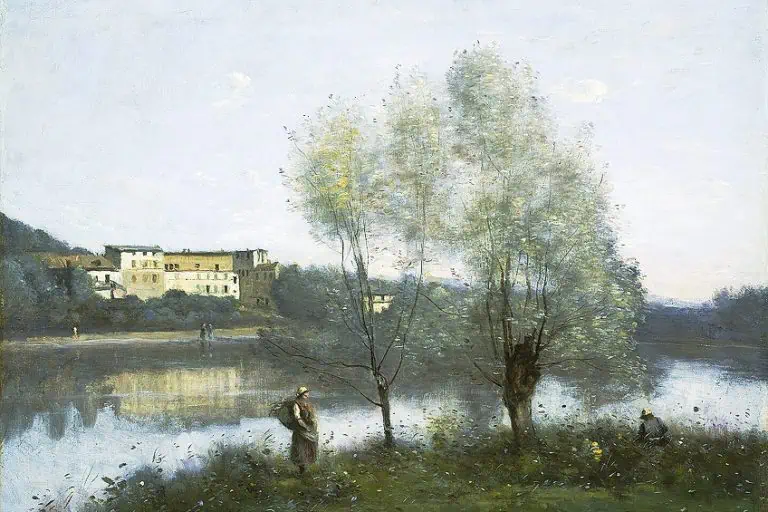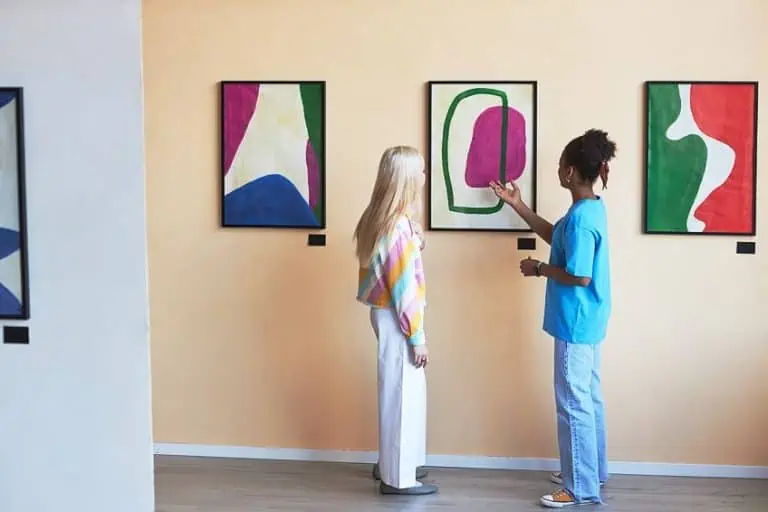Batik Art – A Guide to the Art of Indonesian Wax-Resist Dyeing
This post may contain affiliate links. We may earn a small commission from purchases made through them, at no additional cost to you.
What is batik art, and where did it originate from? The art of batik is practiced by the Javanese people in Indonesia and involves applying wax-resist dye to cloth. Batik artworks are produced using a canting, which is a spouted tool, to add patterns to the cloth, or they can also be pressed on with a stamp. If you want to learn how to make batik or just find out more about the art of batik in general, then carry reading on below!
Table of Contents
What Is Batik Art?
Batik art is a centuries-old Indonesian textile art form that uses wax-resistant dye. Javanese-made Indonesian coastal batik has a long tradition of cultural adjustment, a blending of local and outside cultures. In comparison to inland batik, it is a more recent style and uses more colors, but the patterns are simpler in design.
 Batik print fabric from Surakarta in Central Java province in Indonesia (before 1997); Tropenmuseum, part of the National Museum of World Cultures, CC BY-SA 3.0, via Wikimedia Commons
Batik print fabric from Surakarta in Central Java province in Indonesia (before 1997); Tropenmuseum, part of the National Museum of World Cultures, CC BY-SA 3.0, via Wikimedia Commons
Whereas coastal batik can be produced by anybody, inland batik tended to be created by a small group of specialists who lived and worked close to palaces.
The History of Batik Art
The wax-resist cloth dyeing technique known as batik originated in Java, Indonesia. Some of the best batiks in the world are still produced there, where the art of batik has been developed the most. Beeswax, cotton, and the plants used to make the various vegetable colorants used by batik artists are all easily accessible on the island of Java.
Batik in Indonesia predates written history; some historians believe that it arrived via Sri Lanka or India in either the 6th or 7th century. Others, on the other hand, feel that Indonesian batik is a local practice, because various locations in Indonesia, like Flores, Toraja, and Halmahera, which were not directly impacted by Hinduism, have provided evidence of batik-making traditions.
The first batik activities originated in Ponorogo, which was still known as Wengker prior to the 7th century. Ponorogo taught the Kingdom of Central Java the art of batik. As a result, Ponorogo batik is comparable to the batik art found in Central Java, with the exception that the batik created in Ponorogo is usually dark black and generally referred to as batik irengan. In the late colonial era, Chinese settlers and Dutch Indo-Europeans were interested in producing batik, especially coastal batik. They pioneered the use of copper block stamps to produce batiks en-masse, as well as the creation of innovative designs.
 Photograph of two women batiking traditional loin-cloths taken between 1900 and 1940; Tropenmuseum, part of the National Museum of World Cultures, CC BY-SA 3.0, via Wikimedia Commons
Photograph of two women batiking traditional loin-cloths taken between 1900 and 1940; Tropenmuseum, part of the National Museum of World Cultures, CC BY-SA 3.0, via Wikimedia Commons
These exotic fabrics set off a surge of innovation across Europe. A collective of young artists introduced the art of batik to furniture, interior decoration, and, subsequently, fashion in Amsterdam in the 1890s. This was a huge success, and by the start of the 20th century, thousands of American and European craftspeople and artists were practicing the art of batik. Its popularity peaked between 1918 and 1925 when it was most popular in Germany, Holland, Poland, France, and the United Kingdom.
The popularity of batik art declined in the West until the 1960s when it was revived, examined, and transformed by artists such as Noel Dyrenforth.
Batik Art Materials and Tools
Next, we shall look at the various batik art materials and tools. The materials and tools utilized for batik art vary according to the region in which it is made and the artist’s choice. Let us now take a look at the most commonly used Batic art tools and materials.
Fabric
Batik may be applied to a variety of materials, and the choice is determined by the characteristics you want of the finished artwork.
Cotton is a popular fabric because of its ability to absorb colors efficiently as well as its low cost.
Silk is yet another popular choice of material due to its smooth surface. Artists can additionally use hemp, rayon, or linen according to personal tastes and the requirements of the specific project.
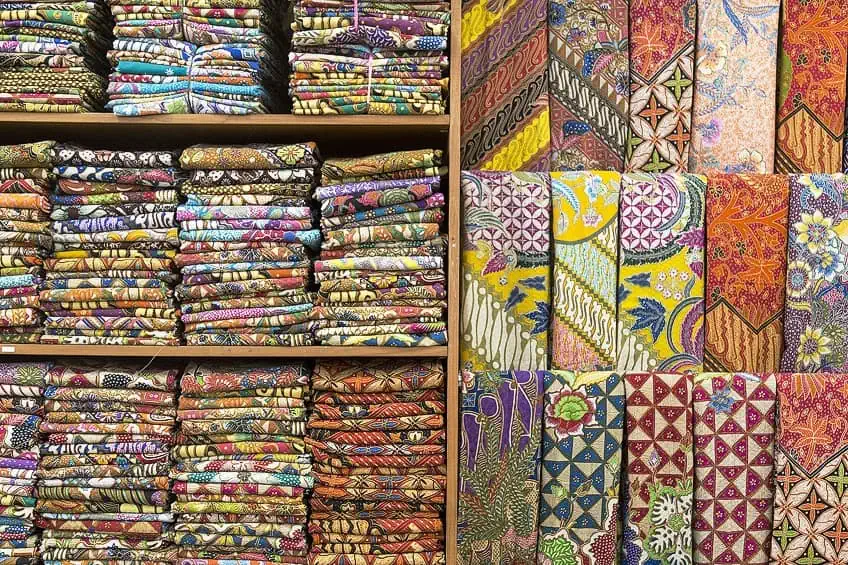 Batik fabrics and patterns; Fpangestuphotographer, CC BY-SA 4.0, via Wikimedia Commons
Batik fabrics and patterns; Fpangestuphotographer, CC BY-SA 4.0, via Wikimedia Commons
Wax
Wax is essential in batik art because it works as a resist, stopping colors from permeating the fabric. Various waxes can be used, based on availability and desired outcomes. The wax is melted in a wok or similar pan. It is heated on an open flame or stove to keep the wax liquid throughout the batik-making process. A few artists melt and then keep the wax at a consistent temperature in a specialized wax pot.
Beeswax is a traditional and natural batik material. Paraffin wax is a synthetic wax readily accessible and used often in batik art. Color is added to the cloth using batik dyes.
Minerals, plants, and insects are used to create natural dyes. Natural dyes produce distinct, earthy tones and are usually valued for their long-term viability and historical relevance. Synthetic dyes provide a more bright and uniform color spectrum and tend to be chosen because of their colorfastness and versatility.
Canting
A canting is a pen-like implement that can be utilized to apply hot wax onto the fabric. It comprises a tiny metal reservoir with a spout and wooden handle. The reservoir is filled with liquid wax, and the flow is controlled by regulating the pressure while you draw on the cloth.
These batik cantings come in a variety of sizes, enabling batik artists to produce a variety of line thicknesses.
Stamps
To apply wax to the cloth, blocks or stamps with carved designs are typically used, and they are usually constructed of copper, wood, or brass. The stamp is dipped in molten wax before being pressed onto the cloth, creating a repeating motif or background design.
Stamps are often employed in order to create uniform patterns or to cover larger parts of the cloth with wax.
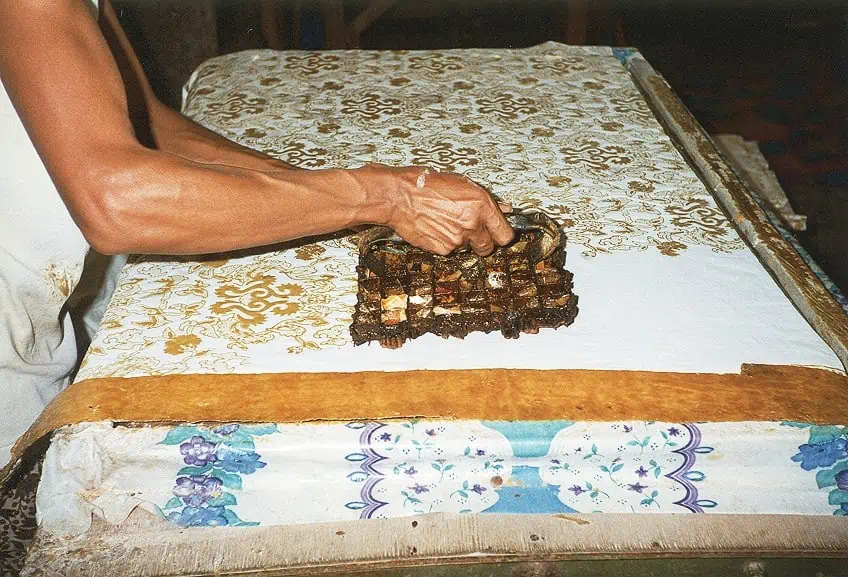 Stamp used in printing wax-resist patterns for making batik; Ian Alexander, CC BY-SA 3.0, via Wikimedia Commons
Stamp used in printing wax-resist patterns for making batik; Ian Alexander, CC BY-SA 3.0, via Wikimedia Commons
The Batik-Making Process
Here, we will find out how to make batik art. Batik is a fabric-resist technique that uses melted wax. The wax can be stamped or painted onto a white or colored cloth using a brush or canting, or it can be imprinted with a copper stamp soaked in molten wax. The cloth is subsequently colored, and the waxed parts will not be penetrated by the dye. To acquire a multicolored result, just repeat the process several times.
The batik maker can deal with fabrics up to 8-10 meters in length. This is due to various phases in the process requiring the cloth to be stretched out on a frame made of wood like a painting.
The maximum operational length of such a frame is limited to 10 meters. When the white cloth has been colored for the first time; this will be the color of the batik’s pattern or motif.
 Women making batik in Ketelan, Central Java; Stephen Kennedy, CC BY 2.0, via Wikimedia Commons
Women making batik in Ketelan, Central Java; Stephen Kennedy, CC BY 2.0, via Wikimedia Commons
Fabric Preparation
The cloth is washed first to eliminate any dirt that might interfere with the dying process. The cloth is then dried and pressed after washing to make sure that it is smooth and free of creases.
Some artists like to apply a mordant to the cloth, such as alum, to improve color fastness and dye absorption.
Batik Pattern Design
The batik artist then creates the batik pattern using motifs influenced by folklore, nature, or popular cultural symbols. These patterns can either be drawn freehand or with the use of stencils. The artist then determines the required colors and arrangement of the pattern.
Applying Wax
To keep the cloth taut throughout the wax application process, it is stretched out and carefully fixed on a frame. In a wax pot, the artist warms the wax until it becomes liquid. The artist then adds hot wax to the cloth using a tjanting, canting, brush, or stamp, covering parts that should remain uncolored.
The wax serves as a resist, stopping dye from permeating the cloth and forming a barrier between the colors.
 Batik craftsman applying wax to cloth; Shubert Ciencia, CC BY 2.0, via Wikimedia Commons
Batik craftsman applying wax to cloth; Shubert Ciencia, CC BY 2.0, via Wikimedia Commons
Fabric Dyeing
The fabric is ready for dyeing once the wax has dried and set on it. Based on the design, the artist then prepares the required dye colors.
The cloth is initially immersed in the lightest dye color, ensuring that the wax-covered sections do not absorb the dye.
After the first color is dyed, the cloth is allowed to dry or washed to get rid of any excess dye. This step is repeated with each successive dye color, moving from lighter to deeper colors. The wax serves as a resist, enabling fresh colors to be absorbed while protecting previously colored sections.
Wax Removal and Finishing
The wax must be removed once the final dye color has been added and the material has dried out. To remove the wax, the cloth was traditionally steamed or boiled.
Modern processes, on the other hand, entail melting and absorbing the wax with an iron or a specific solvent.
Following the removal of the wax, the cloth is washed to get rid of any remaining color and wax. To set the colors and provide a smooth finish, the batik artwork is subsequently dried and pressed. Extra treatments, such as decorations or extra colors, can be added to achieve the desired final design. The resulting batik fabric may be utilized for a variety of purposes, including clothing, wall hangings, and batik art.
 Contemporary men’s batik shirt printed in Central Javanese Surakarta style; Gunawan Kartapranata, CC BY-SA 3.0, via Wikimedia Commons
Contemporary men’s batik shirt printed in Central Javanese Surakarta style; Gunawan Kartapranata, CC BY-SA 3.0, via Wikimedia Commons
Batik Art Styles
The art of Batik goes back many centuries. Therefore, there are various traditional as well as contemporary batik styles. There are also different regional variations of batik art.
Traditional Batik
Traditional batik encompasses established batik-making processes that have been handed down through the centuries from one generation to another. It often includes historical and cultural aspects, conveying regional traditions and practices.
Traditional batik designs are complex and symmetrical, with repeating patterns and motifs that are inspired by nature.
Natural dyes originating from minerals and plants are used to create a subdued and earthy color palette. Traditional batik has huge cultural and aesthetic significance, and it is strongly rooted in the legacy of the places where it was developed.
 Pre-1867 Javanese batik attributed to the workshop owned by Carolina Josephina von Franquemont; Photo courtesy of the Queen Sirikit Museum of Textiles, Bangkok., Public domain, via Wikimedia Commons
Pre-1867 Javanese batik attributed to the workshop owned by Carolina Josephina von Franquemont; Photo courtesy of the Queen Sirikit Museum of Textiles, Bangkok., Public domain, via Wikimedia Commons
Contemporary Batik
The term “contemporary batik” refers to more recent and unconventional approaches to the art of batik. It combines old techniques with modern design features.
Contemporary batik artists use abstract patterns, bright colors, unusual motifs, and a range of different types of fabrics.
Contemporary batik also frequently incorporate mixed media, such as batik combined with other printing or painting methods. Contemporary batik offers more artistic freedom and modern artists also use it to explore certain societal, personal, or political issues.
Regional Batik Styles
Javanese batik from Indonesia is possibly the most well-known and varied batik style. Surakarta, Yogyakarta, and Pekalongan batik are some of the sub-styles. Each of these sub-styles features distinct patterns, themes, and color schemes that represent the region’s cultural heritage. Malaysian batik has become known for its bright colors and eye-catching patterns. Motifs inspired by the local flora and fauna, abstract patterns, and geometric patterns are often used.
Malaysian batik is available in both hand-drawn and block-printed styles. Nigerian batik has its own particular style, which is distinguished by bold motifs and brilliant colors.
Nigerian batik artists like to employ adire, a hand-dyeing method that uses cassava paste as a resist. Batik art is also practiced in Senegal, Ghana, and Mali, among other African countries. Traditional symbols, themes, and patterns are included in African batik, representing the rich cultural past of the individual areas.
 Textile merchant selling African wax-resist printed fabrics; Alexander Sarlay, CC BY-SA 4.0, via Wikimedia Commons
Textile merchant selling African wax-resist printed fabrics; Alexander Sarlay, CC BY-SA 4.0, via Wikimedia Commons
Batik Art Symbolism
Each batik pattern presented has its unique meaning. Historically, a certain type of batik design was employed to denote social position. Some patterns are reserved for aristocracy or royal families. This traditional craft is still practiced today, particularly in a number of Indonesian palaces. To learn more about batik, you must first grasp the many different batik designs and their symbolic connotations.
 Batik tulis Jawa Hokokai from Pekalongan, with dawn-dusk pattern, butterflies, and cherry blossoms motif; Gandrasta Bangko, CC BY-SA 3.0, via Wikimedia Commons
Batik tulis Jawa Hokokai from Pekalongan, with dawn-dusk pattern, butterflies, and cherry blossoms motif; Gandrasta Bangko, CC BY-SA 3.0, via Wikimedia Commons
Batik Sidoluhur
This batik design is similar to Sidomukti. The bride usually wears an Indonesian Sidoluhur batik design on her wedding night. Choosing the Batik Sidoluhur design for the wedding ceremony is also regarded as a type of prayer for the bride to remain well and to grow into a person of honor and dignity.
Batik Parang
The Batik Parang design is a popular traditional batik pattern. This design, which is shaped like waves, represents a life struggle and is reminiscent of sea waves striking a reef.
 Example of Parang style batik; Internet Archive Book Images, No restrictions, via Wikimedia Commons
Example of Parang style batik; Internet Archive Book Images, No restrictions, via Wikimedia Commons
People who wear this batik design are supposed to persevere and never give up in the face of the challenges that life brings.
Parang Barong, Parang Rusak, Parang Kecil, Parang Kusumo, Parang Klitik, and Parang Slobog are the six patterns of Batik Parang. This design has its own peculiar characteristics, particularly the Parang Barong pattern, which is restricted to being worn by members of the royal family.
Batik Sekar Jagad
In addition to the Batik Parang design, the royal communities utilized the Sekar Jagad batik pattern. This batik pattern design is from the cities of Yogyakarta and Solo in Indonesia. The name Sekar Jagad is derived from the Dutch word “Kar” (map), and the Javanese word “Jagad”, which means globe. As a result, this theme represents cultural variety in Indonesia and across the world.
Cirebon is the origin of this batik pattern. It has a cloud-like design. While the pattern’s name means “dark cloud,” it does not imply melancholy.
This form of batik actually represents patience, not being too emotional, and being attentive while resolving an issue. Furthermore, the Mega Mendung design features seven color gradations that represent the seven strata of the sky.
Batik Kawung
Batik Kawung is one of Indonesia’s earliest batik designs. Designed to look like neatly placed sugar palm fruit.
This batik represents people who are always mindful of their roots.
Additionally, the Kawung pattern represents the capacity to suppress lust, preserve balance in one’s behavior, justice, and courage. As a result, many ancient leaders wore batik with this design.
 Kawung or “Coffee-Bean” batik design; Alteaven, CC BY-SA 3.0, via Wikimedia Commons
Kawung or “Coffee-Bean” batik design; Alteaven, CC BY-SA 3.0, via Wikimedia Commons
Batik Truntum
For romantics, the Batik Truntum design is an excellent choice. This design has an important meaning since it represents reborn love. This form of batik, which is mostly centered on floral designs, suggests that in order to keep love blooming, it must be constantly cared for, much like irrigated flowers, so that it does not wither with time.
Batik Sidomukti
Batik Sidomukti style can be found in significant Javanese traditional occasions such as inaugurations or weddings, particularly in Solo and Yogyakarta. The coloring process, which employs natural substances such as soybean, is the primary distinguishing characteristic of this batik. In Batik Sidomukti, the soga or brown color is the ancient and original classic batik color.
Sidomukti derives its name from the words “sido” (to endure) and “mukti” (noble). As a result, wearing this batik design is also a representation of prayers and hope that those who wear it will be blessed with continued wealth and glory.
Batik in International Fashion
Batik has already established itself in the modern fashion sector on a global scale. Batik fabric is now employed in fields such as haute couture, in addition to accessories like purses and is no longer used solely used for traditional apparel. Many famous people have walked the red carpet wearing batik, including Nelson Mandela, Bill Gates, and Barack Obama, as well as Jessica Alba and Beyoncé Knowles.
Indonesian designers have introduced batik to the worldwide fashion market by combining the fabric with contemporary patterns and production processes.
Iwan Tirta, for instance, is well-known for his batik shirt designs, which were worn at the APEC Summit by the head of state in 1994; Ramli, who innovated the use of batik on modern apparel such as jackets, boleros, and suits; and Obin, who pioneered processes in making new batik materials. Other designer’s works, such as those of Edward Hutabarat, Ghea Panggabean, Poppy Darsono, and many more, have also helped to promote batik on a global scale. These breakthroughs have also motivated internationally recognized designers from other nations to include batik in their design collections.
 Former South African president Nelson Mandela wearing one of his signature batik-style shirts meeting Former U.S. president George W. Bush; Eric Draper, White House Photographer, Public domain, via Wikimedia Commons
Former South African president Nelson Mandela wearing one of his signature batik-style shirts meeting Former U.S. president George W. Bush; Eric Draper, White House Photographer, Public domain, via Wikimedia Commons
For example, Kate Middleton, the Princess of Wales, wore a batik dress by Diane von Furstenberg, the Belgian-American designer, while Angelina Jolie wore one by Nicole Miller, the U.S. designer. Other foreign designers that included batik in their collections include Belgium’s Dries van Noten, Thailand’s Ek Throngprassert, and Milo Milavica from Italy. Furthermore, Koefia, one of Italy’s oldest fashion schools, has not only incorporated batik fashion into its curriculum but has also displayed its fashionable creations on the runway.
Batik fabric is also exported to several nations, including South Korea, the United States, Germany, Japan, the Netherlands, and the United Kingdom.
Recognition from UNESCO and decades of international acclaim have undoubtedly enhanced Indonesians’ pride in batik, resulting in the birth of new and sophisticated batik businesses. The incorporation of batik in furnishings and homeware has also grown more widespread among high-end businesses.
That completes our look at the art of batik. We have found out all about the different styles of batik art, as well as the symbolism of the various batik patterns. We also explored the impact of batik art on the international art scene. As we have discovered, the art of batik is centuries old, yet still has an impact on the current fashion circuit. From the traditional batik styles to the more contemporary styles, Batik art continues to be influential well into the modern age.
Frequently Asked Questions
What Are the Colorants Used by Batik Artists?
Natural plant dyes have been extensively used in traditional batik. These dyes come in a variety of muted colors. Some natural colors come from insects, which provide pink and red hues. Iron oxide and ochre, for example, can be employed as natural colorants for creating earth tones. Acid dyes are synthetic colors that are mostly employed on protein-based fibers such as silk. They provide batik artists with long-lasting colors and need an acidic atmosphere for the dyeing process, such as citric acid or vinegar.
What Is Batik Art?
Batik is a traditional cloth produced using the wax-resist process that has significant symbolism linked with each specific design. This tradition stretches back to the time of Indonesia’s ancient kingdoms. The cloth originated in Java, with elements taken from Arabian, Chinese, and even European acculturations. However, other regions in Indonesia are now producing their own batik motifs that are deemed equal to the original Javanese patterns. Nonetheless, with the rise of Western influence following Indonesia’s independence, the centuries-old traditional fabric lost its appeal to the younger population. However, today, it is as popular as ever, with modern fashion designers incorporating the technique into their works.
In 2005, Charlene completed her wellness degrees in therapeutic aromatherapy and reflexology at the International School of Reflexology and Meridian Therapy. She worked for a company offering corporate wellness programs for several years before opening her own therapy practice. In 2015, she was asked by a digital marketer friend to join her company as a content creator, and it was here that she discovered her enthusiasm for writing. Since entering the world of content creation, she has gained a lot of experience over the years writing about various topics such as beauty, health, wellness, travel, crafting, and much more. Due to various circumstances, she had to give up her therapy practice and now works as a freelance writer. Since she is a very creative person and as a balance to writing likes to be active in various areas of art and crafts, the activity at acrylgiessen.com is perfect for her to contribute their knowledge and experience in various creative topics.
Learn more about Charlene Lewis and about us.
